生物医用材料的展望 中英文对照
- 格式:pdf
- 大小:396.90 KB
- 文档页数:12

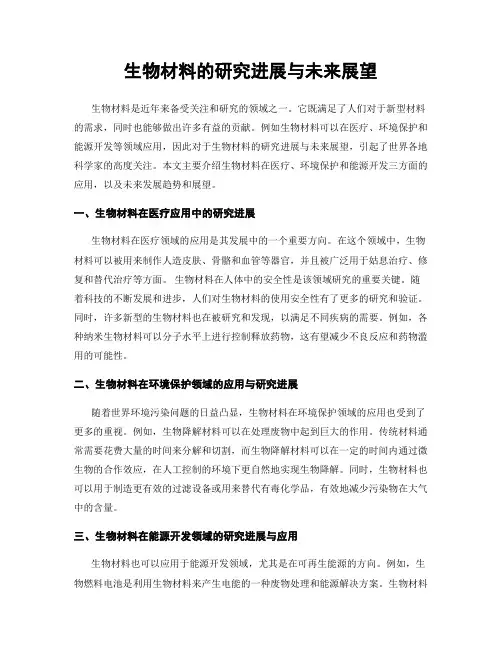
生物材料的研究进展与未来展望生物材料是近年来备受关注和研究的领域之一。
它既满足了人们对于新型材料的需求,同时也能够做出许多有益的贡献。
例如生物材料可以在医疗、环境保护和能源开发等领域应用,因此对于生物材料的研究进展与未来展望,引起了世界各地科学家的高度关注。
本文主要介绍生物材料在医疗、环境保护和能源开发三方面的应用,以及未来发展趋势和展望。
一、生物材料在医疗应用中的研究进展生物材料在医疗领域的应用是其发展中的一个重要方向。
在这个领域中,生物材料可以被用来制作人造皮肤、骨骼和血管等器官,并且被广泛用于姑息治疗、修复和替代治疗等方面。
生物材料在人体中的安全性是该领域研究的重要关键。
随着科技的不断发展和进步,人们对生物材料的使用安全性有了更多的研究和验证。
同时,许多新型的生物材料也在被研究和发现,以满足不同疾病的需要。
例如,各种纳米生物材料可以分子水平上进行控制释放药物,这有望减少不良反应和药物滥用的可能性。
二、生物材料在环境保护领域的应用与研究进展随着世界环境污染问题的日益凸显,生物材料在环境保护领域的应用也受到了更多的重视。
例如,生物降解材料可以在处理废物中起到巨大的作用。
传统材料通常需要花费大量的时间来分解和切割,而生物降解材料可以在一定的时间内通过微生物的合作效应,在人工控制的环境下更自然地实现生物降解。
同时,生物材料也可以用于制造更有效的过滤设备或用来替代有毒化学品,有效地减少污染物在大气中的含量。
三、生物材料在能源开发领域的研究进展与应用生物材料也可以应用于能源开发领域,尤其是在可再生能源的方向。
例如,生物燃料电池是利用生物材料来产生电能的一种废物处理和能源解决方案。
生物材料可以用来作为燃料电池的催化剂,从而实现产生能量并减少废物量的效果。
同时,生物材料也可以用来制造能源储备器和其他应用场景中所需的各种电池和电子设备。
未来展望生物材料领域将继续得到重视和投入研究,因为它的应用范围越来越广泛,正面临不断增加的机遇和挑战。


生物3D打印与生物医用材料产业现状及市场展望分析3D打印技术与新的医学信息获取技术相结合,以生物医用材料及细胞为新型离散材料,通过技术设计,快速有效的生产出医疗相关产品,这一过程称为生物3D打印。
生物3D打印具有巨大的临床需求和科学意义,采用该技术快速精准的制造出满足不同个性化需求的组织、器官等,并对其微观结构精准控制,能够大大缓解组织器官紧缺的问题。
生物3D打印技术的发展一方面依靠工程技术的不断改进和升级,另一方面依靠生物医用材料性能的不断提升和新材料的开发应用。
两者相互作、互相影响、交替发展,无论是生物3D打印技术还是相关生物医用材料的飞速发展,都意味着生物3D打印已经迎来了更加广阔的未来和发展空间。
一、生物3D打印技术生物3D打印技术是多学科融合交叉诞生的一门新兴学科,通过突破传统的制造技术,结合生命科学相关内容,生产制造出可用于人工植入、修复重建、完全替代人体组织或器官。
该技术涉及仿生制造,功能结构生物体制造,再生医学模型制造,体外生物生理、病理和药理模型制造及以细胞和活性分子为基础的细胞/组织芯片和先进医疗诊断设备的制造等诸多领域,是目前3D打印技术的最高水平体现之一。
生物3D打印技术发展迅速,已经在短短的20多年发展历中经历了4个阶段[1]。
从最初的打印体外医疗器械与医学模型开始,对使用材料没有生物相容性的要求,到打印生物相容性较好、不能降解的永久性植入材料,经历了材料性能根据需求提升的阶段。
接下来,生物3D打印使用的材料性能更优,既具有良好的生物相容性,又可被降解吸收,打印产品植入后能与组织发生相互作用,促进其再生。
这3个阶段的发展,依赖于材料本身性能的优化和提升,同时对3D技术革新提出了更高的要求。
目前,前3个阶段的技术发展成熟,已经应用到实际研究与临床治疗,如药物控释支架制备、活性大段人工骨、活性人工软骨制备等,同时也利用计算机辅助设备,直接进行复杂骨科手术、颅骨修复、小耳畸形修复和口腔正畸等。
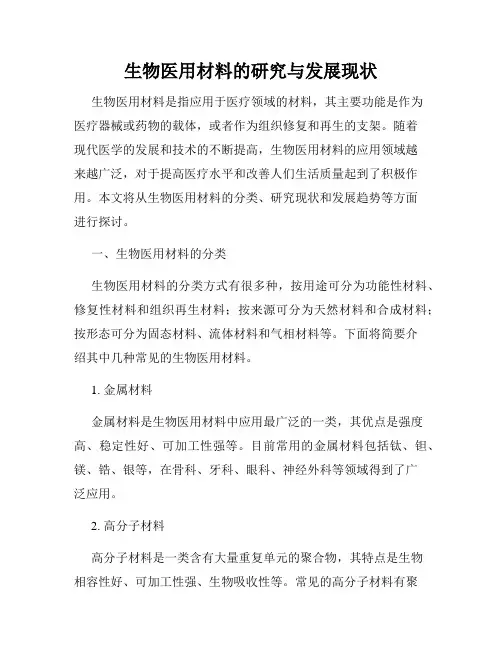
生物医用材料的研究与发展现状生物医用材料是指应用于医疗领域的材料,其主要功能是作为医疗器械或药物的载体,或者作为组织修复和再生的支架。
随着现代医学的发展和技术的不断提高,生物医用材料的应用领域越来越广泛,对于提高医疗水平和改善人们生活质量起到了积极作用。
本文将从生物医用材料的分类、研究现状和发展趋势等方面进行探讨。
一、生物医用材料的分类生物医用材料的分类方式有很多种,按用途可分为功能性材料、修复性材料和组织再生材料;按来源可分为天然材料和合成材料;按形态可分为固态材料、流体材料和气相材料等。
下面将简要介绍其中几种常见的生物医用材料。
1. 金属材料金属材料是生物医用材料中应用最广泛的一类,其优点是强度高、稳定性好、可加工性强等。
目前常用的金属材料包括钛、钽、镁、锆、银等,在骨科、牙科、眼科、神经外科等领域得到了广泛应用。
2. 高分子材料高分子材料是一类含有大量重复单元的聚合物,其特点是生物相容性好、可加工性强、生物吸收性等。
常见的高分子材料有聚乳酸(PLA)、聚己内酯(PCL)、聚酯多元醇(PEU)、聚乳酸-羟基磷灰石(PLA/HA)等。
它们在骨组织修复、软组织修复、人工血管等方面也有较广泛应用。
3. 磁性材料磁性材料是一类具有一定磁性的材料,其主要应用是为了实现对其在体内的跟踪、定位和靶向治疗。
常见的磁性材料有氧化铁、钙钛矿等。
4. 生物陶瓷材料生物陶瓷材料是一类由无机物质制成的材料,其应用主要集中在骨组织修复、关节假体、牙科修复等方面。
生物陶瓷材料具有很高的生物相容性、无毒性、能促进骨组织重建等优点。
目前常用的生物陶瓷材料有氧化锆、氢氧化钙、氢氧化磷灰石等。
二、生物医用材料的研究现状生物医用材料研究是生物医学工程领域的重要分支之一,其发展与人类生命健康息息相关。
随着生物医学技术的不断发展,生物医用材料的研究也越来越深入。
下面我们将从材料表面纳米结构、基因修饰、生物打印等几个方面介绍生物医用材料的研究现状。
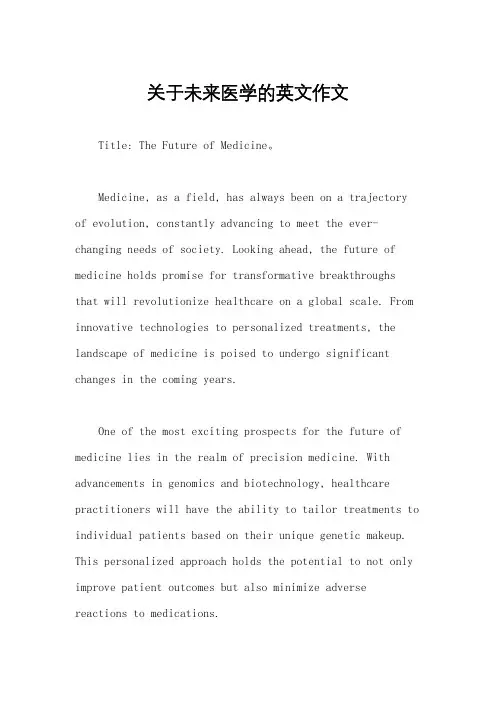
关于未来医学的英文作文Title: The Future of Medicine。
Medicine, as a field, has always been on a trajectory of evolution, constantly advancing to meet the ever-changing needs of society. Looking ahead, the future of medicine holds promise for transformative breakthroughsthat will revolutionize healthcare on a global scale. From innovative technologies to personalized treatments, the landscape of medicine is poised to undergo significant changes in the coming years.One of the most exciting prospects for the future of medicine lies in the realm of precision medicine. With advancements in genomics and biotechnology, healthcare practitioners will have the ability to tailor treatments to individual patients based on their unique genetic makeup. This personalized approach holds the potential to not only improve patient outcomes but also minimize adverse reactions to medications.Artificial intelligence (AI) is another area poised to reshape the practice of medicine. By harnessing the power of machine learning algorithms, healthcare providers can analyze vast amounts of medical data to identify patterns and trends that may not be apparent to the human eye. This can lead to earlier detection of diseases, more accurate diagnoses, and optimized treatment plans.Telemedicine is also set to play a significant role in the future of healthcare delivery. With the increasing availability of high-speed internet and mobile devices, patients will have greater access to medical care from the comfort of their own homes. This can be especially beneficial for individuals in rural or underserved areas who may have limited access to healthcare facilities.Advancements in medical robotics are poised to revolutionize surgical procedures. From minimally invasive techniques to robotic-assisted surgeries, these technologies offer greater precision and control, resulting in shorter recovery times and improved patient outcomes.Additionally, remote surgical capabilities could enable surgeons to perform procedures on patients located in different parts of the world, expanding access to specialized care.Nanotechnology holds promise for the development of targeted drug delivery systems and advanced imaging techniques. By engineering nanoparticles to deliver medication directly to diseased cells, researchers can enhance the efficacy of treatments while minimizing side effects. Similarly, nanoscale imaging technologies offer unprecedented insights into cellular structures and biological processes, enabling earlier detection of diseases such as cancer.The integration of big data analytics into healthcare systems will enable more efficient and cost-effective delivery of care. By aggregating and analyzing data from electronic health records, wearable devices, and other sources, healthcare providers can identify population health trends, predict disease outbreaks, and allocate resources more effectively. This data-driven approach hasthe potential to transform healthcare from reactive to proactive, focusing on prevention rather than treatment.In conclusion, the future of medicine holds immense promise for improving patient outcomes, enhancing the delivery of care, and advancing our understanding of human health and disease. Through innovations in precision medicine, artificial intelligence, telemedicine, robotics, nanotechnology, and big data analytics, we are poised to enter a new era of healthcare that is more personalized, efficient, and effective than ever before. As we continue to push the boundaries of medical science, thepossibilities for improving human health are truly limitless.。

生物材料在医疗领域中的前景和挑战随着科技不断发展,生物材料在医疗领域中的应用越来越广泛。
生物材料指的是一种具有生物相容性和生物反应性的材料,它们在医疗领域中被用来制造各种医疗器具和部件,如矫形器、人工关节、牙科填充材料等。
今天,我们将探讨生物材料在医疗领域中的前景和挑战。
一、生物材料在医疗领域中的前景1.1 可持续发展与传统医疗设备相比,生物材料更适合可持续发展领域。
这是因为,生物材料不仅可以减轻医疗设备对环境的负担,更重要的是,生物材料可以更好地满足人类生命健康的需要。
例如,使用生物材料可以避免矫形器等医疗设备对人体造成的创伤,提高治疗效果。
1.2 增强医疗器械的安全性和适用性生物材料的使用可以增强医疗器械的安全性和适用性。
由于生物材料具有更好的生物相容性和生物反应性,使得其在医疗器械中的具有更好的适用性和安全性,更大程度地避免医疗器械对人体健康造成的危害。
1.3 促进医学发展生物材料的应用有助于促进医学的发展。
现代医学史上最重要的一次技术革命是从传统手术到微创手术的转变,而生物材料的发展正是推动这一进程的重要推手。
使用生物材料可以使得医生在进行微创手术时更加方便,医疗器具的适配性更高,进一步提高医生的操作效率。
二、生物材料在医疗领域中的挑战2.1 控制生物材料的发展尽管生物材料在医疗设备领域有广泛应用,但是其技术发展的前景也面临着风险和挑战。
特别是在控制生物材料的发展上,业内需要保持清醒的认识。
2.2 规范生物材料市场生物材料市场的蓬勃发展需要更加规范的市场监管。
截至目前,部分生物材料市场乱象丛生,存在着生产不合格、质量不稳定等问题,给人们的健康带来了风险和挑战。
因此,加强市场监管是管理生物材料市场的非常重要的一项任务。
2.3 提高恢复速度最后一个挑战是提高恢复速度。
随着生物材料的使用进一步推广,提高恢复速度也成为重要的问题。
在生物材料领域,我们需要更多的研究,以寻求更好的治疗方案、提高生物材料运用的效果和适用性。

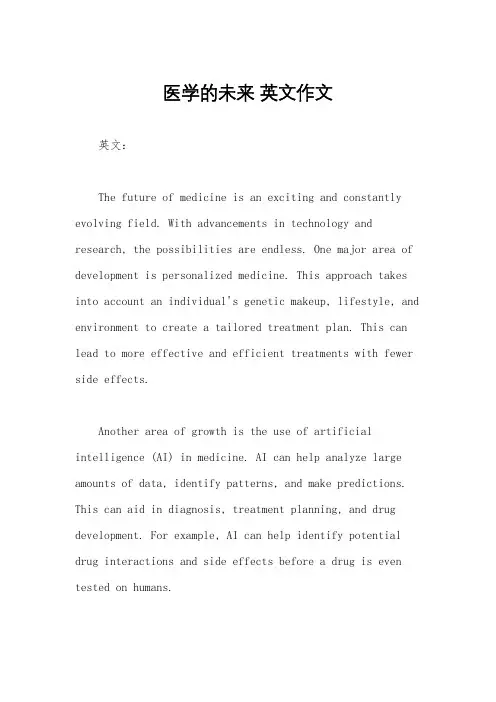
医学的未来英文作文英文:The future of medicine is an exciting and constantly evolving field. With advancements in technology and research, the possibilities are endless. One major area of development is personalized medicine. This approach takes into account an individual's genetic makeup, lifestyle, and environment to create a tailored treatment plan. This can lead to more effective and efficient treatments with fewer side effects.Another area of growth is the use of artificial intelligence (AI) in medicine. AI can help analyze large amounts of data, identify patterns, and make predictions. This can aid in diagnosis, treatment planning, and drug development. For example, AI can help identify potential drug interactions and side effects before a drug is even tested on humans.In addition, telemedicine is becoming more prevalent. This allows patients to receive medical care remotely, without the need for an in-person visit. This can be especially beneficial for those living in rural areas or with mobility issues. Telemedicine can also help reduce healthcare costs and improve access to care.Overall, the future of medicine holds great promise for improving patient outcomes and advancing healthcare as a whole.中文:医学的未来是一个令人兴奋且不断发展的领域。
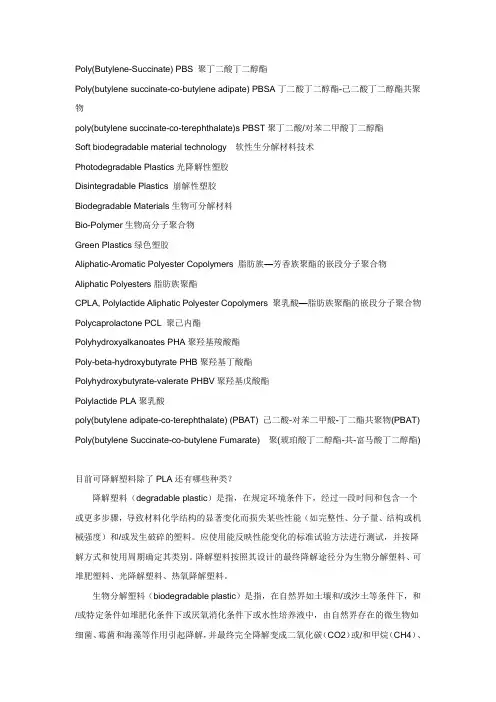
Poly(Butylene-Succinate) PBS 聚丁二酸丁二醇酯Poly(butylene succinate-co-butylene adipate) PBSA丁二酸丁二醇酯-己二酸丁二醇酯共聚物poly(butylene succinate-co-terephthalate)s PBST聚丁二酸/对苯二甲酸丁二醇酯Soft biodegradable material technology 软性生分解材料技术Photodegradable Plastics光降解性塑胶Disintegradable Plastics 崩解性塑胶Biodegradable Materials生物可分解材料Bio-Polymer生物高分子聚合物Green Plastics绿色塑胶Aliphatic-Aromatic Polyester Copolymers 脂肪族—芳香族聚酯的嵌段分子聚合物Aliphatic Polyesters脂肪族聚酯CPLA, Polylactide Aliphatic Polyester Copolymers 聚乳酸—脂肪族聚酯的嵌段分子聚合物Polycaprolactone PCL 聚己内酯Polyhydroxyalkanoates PHA聚羟基羧酸酯Poly-beta-hydroxybutyrate PHB聚羟基丁酸酯Polyhydroxybutyrate-valerate PHBV聚羟基戊酸酯Polylactide PLA聚乳酸poly(butylene adipate-co-terephthalate) (PBAT) 己二酸-对苯二甲酸-丁二酯共聚物(PBAT) Poly(butylene Succinate-co-butylene Fumarate) 聚(琥珀酸丁二醇酯-共-富马酸丁二醇酯)目前可降解塑料除了PLA还有哪些种类?降解塑料(degradable plastic)是指,在规定环境条件下,经过一段时间和包含一个或更多步骤,导致材料化学结构的显著变化而损失某些性能(如完整性、分子量、结构或机械强度)和/或发生破碎的塑料。
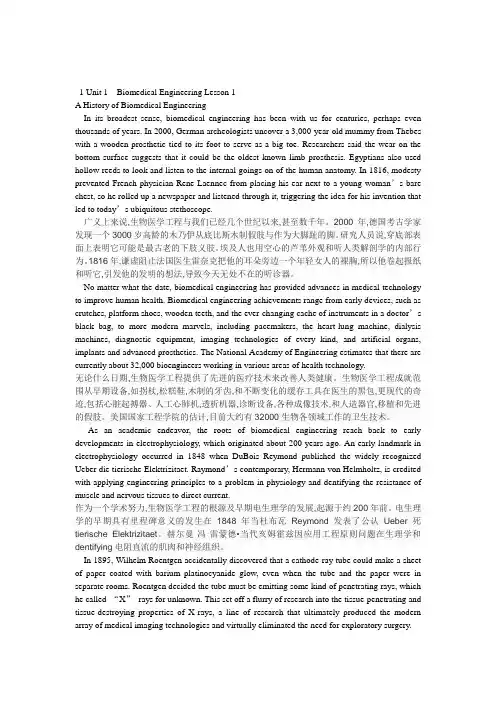
1 Unit 1 Biomedical Engineering Lesson 1A History of Biomedical EngineeringIn its broadest sense, biomedical engineering has been with us for centuries, perhaps even thousands of years. In 2000, German archeologists uncover a 3,000-year-old mummy from Thebes with a wooden prosthetic tied to its foot to serve as a big toe. Researchers said the wear on the bottom surface suggests that it could be the oldest known limb prosthesis. Egyptians also used hollow reeds to look and listen to the internal goings on of the human anatomy. In 1816, modesty prevented French physician Rene Laennec from placing his ear next to a young woman’s bare chest, so he rolled up a newspaper and listened through it, triggering the idea for his invention that led to today’s ubiquitous stethoscope.广义上来说,生物医学工程与我们已经几个世纪以来,甚至数千年。
2000年,德国考古学家发现一个3000岁高龄的木乃伊从底比斯木制假肢与作为大脚趾的脚。
医生职业前景展望英文作文The future prospects for the medical profession are promising. With advancements in technology and increased awareness of health and wellness, the demand for doctors will continue to grow. As the population ages, there will be a greater need for medical professionals to provide specialized care for the elderly. Additionally, the rise of chronic diseases such as diabetes and heart disease will require doctors to focus on prevention and long-term management. The field of medicine is constantly evolving, and doctors will need to adapt to new treatments and technologies to meet the changing needs of patients.In recent years, there has been a shift towards a more holistic approach to healthcare. Patients are becoming more interested in alternative and complementary therapies, such as acupuncture and herbal medicine. As a result, doctors will need to have a broader understanding of different treatment options and be able to provide personalized care to meet the individual needs of their patients. This willrequire doctors to have strong communication skills and the ability to build trust and rapport with their patients.The field of medical research is also expanding rapidly. With new discoveries and breakthroughs, doctors will have access to innovative treatments and therapies. This willnot only improve patient outcomes but also provide doctors with exciting opportunities to contribute to medical advancements. Doctors will need to stay up-to-date with the latest research and be willing to collaborate with other healthcare professionals to ensure the best possible carefor their patients.In addition to traditional medical practices, there is also a growing demand for doctors in non-clinical roles. Many doctors are now working in healthcare administration, insurance companies, and pharmaceutical companies. These roles allow doctors to utilize their medical knowledge and expertise in a different capacity, while still making a significant impact on patient care and outcomes.Overall, the future of the medical profession is bright.With advancements in technology, a focus on holistic healthcare, and opportunities for research and innovation, doctors will continue to play a crucial role in improving the health and well-being of individuals and communities. The field of medicine offers a wide range of career options and the potential for personal and professional growth.。
生物医用材料 The manuscript was revised on the evening of 2021生物医学材料指的是一类具有特殊性能、特种功能,用于人工器官、外科修复、理疗康复、诊断、治疗疾患,而对人体组织不会产生不良影响的材料。
现在各种合成材料和天然高分子材料、金属和合金材料、陶瓷和碳素材料以及各种复合材料,其制成产品已经被广泛地应用于临床和科研。
生物医用材料是用来对于生物体进行诊断、治疗、修复或替换其病损组织、器官或增进其功能的新型高技术材料,它是研究人工器官和医疗器械的基础,己成为材料学科的重要分支,尤其是随着生物技术的莲勃发展和重大突破,生物材料己成为各国科学家竞相进行研究和开发的热点。
二关键词:生物,医学,材料,医疗器械,创伤,组织,植入biomedical material, new materials三文献综述1生物医用材料定义生物医用材料(biomedical material)是用于对生物体进行诊断、治疗、修复或替换其病损组织、器官或增进其功能的新型高技术材料。
它是研究人工器官和医疗器械的基础,己成为材料学科的重要分支,尤其是随着生物技术的莲勃发展和重大突破,己成为各国科学家竞相进行研究和开发的热点。
当代生物材料已处于实现重大突破的边缘,不远的将来,科学家有可能借助于生物材料设计和制造整个人体器官,生物医用材料和制品产业将发展成为本世纪世界经济的一个支柱产业.由生物分子构成生物材料,再由生物材料构成生物部件。
生物体内各种材料和部件有各自的生物功能。
它们是“活”的,也是被整体生物控制的。
生物材料中有的是结构材料,包括骨、牙等硬组织材料和肌肉、腱、皮肤等软组织;还有许多功能材料所构成的功能部件,如眼球晶状体是由晶状体蛋白包在上皮细胞组成的薄膜内而形成的无散射、无吸收、可连续变焦的广角透镜。
在生物体内生长有不同功能的材料和部件,材料科学的发展方向之一是模拟这些生物材料制造人工材料。
生物医学工程专业外文文献翻译
引言
本文对生物医学工程领域的外文文献进行了翻译,旨在介绍该
领域的最新研究进展和技术应用。
文献一:生物医学传感器的发展趋势
这篇文献探讨了生物医学传感器在医学领域中的应用,并展望
了其未来的发展趋势。
生物医学传感器具有实时监测生理参数、提
供个性化医疗服务和远程医疗监护等优势。
未来发展方向包括材料
创新、信号处理技术和无线通信等方面。
文献二:生物医学影像技术的应用
本文介绍了生物医学影像技术在诊断、治疗和疾病预防方面的
应用。
生物医学影像技术包括X射线、CT、MRI等多种成像技术,能够提供准确的疾病诊断和治疗监测。
当前的研究重点是提高成像
分辨率、减少辐射剂量以及开发新的成像技术和算法。
文献三:生物医学工程在假肢设计中的应用
这篇文献探讨了生物医学工程在假肢设计方面的应用。
生物医
学工程技术可以提供个性化的假肢设计解决方案,使假肢更加舒适、适应性更强,并提高使用者的生活质量。
目前的研究重点包括材料
的选择、运动控制技术和传感器应用等方面。
结论
生物医学工程领域的外文文献介绍了生物医学传感器、生物医
学影像技术和假肢设计等方面的最新研究进展和应用。
未来的发展
方向包括技术创新、材料研发和信号处理等方面,将会进一步推动
生物医学工程在医学领域的应用和发展。